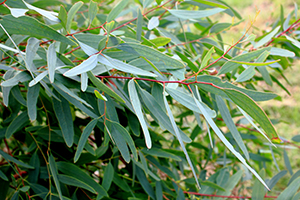Eucalyptus argophloia


Other common names
Chinchilla White Gum, Queensland White Gum
Origin of the species name
Eucalyptus from Latin meaning well-covered and describes the cap on the flower bud; argophloia from Greek argos meaning white or bright, and phloios meaning bark.
Family
Myrtaceae
Date planted
February 2009
Lifespan
Unknown

General description
This is a medium-sized to tall evergreen tree and usually has a very upright form with often more than half the trunk's height clear of branches. It has a striking smooth white trunk on which older bark can become a colourful pinkish grey. The sometimes narrow lance-shaped leaves grow to about 15cm and the small hemispherical fruit are held in groups of up to seven. Height 35m Spread 10m.
Natural distribution and habitat
The species is native to southern inland Queensland, Australia where it grows in clayey soils on or near the edges of flats, in areas with limited topographic relief.
Conservation status
It is classified as a threatened species and the main identified threat continues to be habitat destruction for agriculture and grazing. Potential threats include: harvesting for timber; lack of seedling regeneration due to weeds or planted pasture species, and road widening and maintenance activity. Its spread is now very restricted and is found in an area of only 15,000 hectares.
Uses
The timber is very hard and highly resistant to decay when in contact with the ground or in damp or poorly ventilated conditions. The heartwood is deep red, hard, heavy and strong. The wood has been used for poles, posts, general construction and firewood. Oil from the leaves has potential for medicinal use but the concentration in the leaves is low.
Planting pattern
Planted in clusters of seven trees with six trees forming a hexagon and one on the centre. Rows of trees have also been planted around the forest boundary in a regular diamond grid pattern.
Further reading
Boland DJ, MIH Brooker, GM Chippendale, N Hall, BPM Hyland, RD Johnston, DA Kleinig, MW McDonald and JD Turner (2006) Forest Trees of Australia (5th Edition) CSIRO Publishing.
